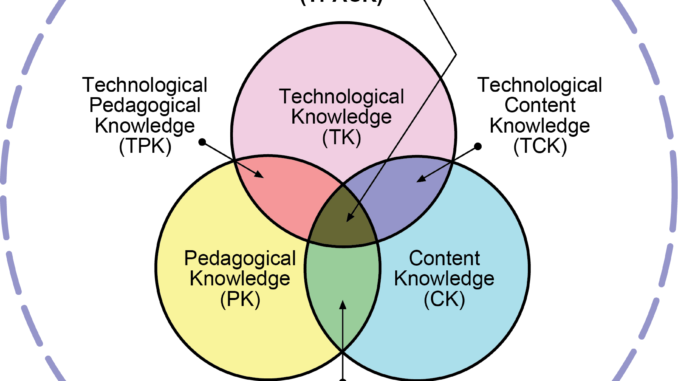
By Amber Hartwell
With the proliferation of new educational technologies and participatory learning opportunities, a shift in Canada to transform traditional libraries into library learning commons (LLC) spaces is occurring (Loertscher, Koechlin & Zwaan, 2008). In 2008, the first book highlighting the LLC was published, redefining this learning space (Loertscher, et al., 2008). In 2014, the Canadian Library Association released Leading Learning: Standards of Practice for School Library Learning Commons in Canada, “to provide vision and practical strategies for those responsible for and committed to viable and successful school libraries in Canada” (Canadian Library Association, 2014 / Canadian School Libraries, 2020). Similarly, professional entities had begun developing implementation guides and policies to assist schools in this transformation (Faber, 2014; McMullen, 2008; Ontario School Library Association, 2010).
An integral component of a successful LLC is the organization of specialists – the teacher-librarian (TL), reading specialist, technology-integration specialist, curriculum specialist – who share a common vision of trying to reach all teachers and breaking classroom isolation (Loertscher & Koechlin, 2014). In this space, the TL’s role is comprehensive. In addition to promoting literacy, managing resources, and building relationships, the TL is responsible for cultivating “effective instructional design to co-plan, teach and assess learning” (Canadian School Libraries, 2020). For example, a TL may work with a history teacher to design an inquiry into the causes of World War I. Through co-planning, required research skills and background knowledge can be identified, and resources curated. During instruction, both the TL and classroom teacher are made available to support student learning. Finally, assessment can be completed together, providing multiple perspectives into the learning process. This practice enables each educator to provide expertise in individual areas of strength while also learning from one another. However, finding an entry point to cultivate such opportunities can be difficult. In addition to individual knowledge and skill sets, a TL must be able to successfully collaborate with varying pedagogical approaches and teaching philosophies (Loertscher & Koechlin, 2014). One framework that supports TLs in co-planning, teaching and assessing is TPACK, a theory of effective teaching, including subject, technology, and pedagogical knowledge (Mishra & Koehler, 2006). This paper defines a LLC in K-12 schools, provides an overview of TPACK, explains how TPACK can be used as an entry point to co-planning, teaching and assessing opportunities for the TL, and shares an example of effective TPACK use. Finally, strengths and challenges of using TPACK for co-planning, teaching and assessing will be discussed.
The Library Learning Commons
The LLC model is a school-wide approach to building a participatory learning community. Encompassing physical and virtual environments, the LLC aims to provide a collaborative space that supports inquiry and project-based learning. Here, “reading thrives, learning literacies and technology competencies evolve, and critical thinking, creativity, innovation and playing to learn are nourished” (Canadian School Libraries, 2020). This allows for the creation of a personalized learning environment to improve learning (Loertscher, Koechlin & Rosenfeld, 2012). Ultimately, the LLC model is about changing school culture, transforming the way teaching and learning occur. To achieve this, Leading Learning developed five core standards: facilitating collaborative engagement to cultivate and empower a community of learners; advancing the learning community to achieve school goals; cultivating effective instructional design to co-plan, teach and assess learning; fostering literacies to empower life-long learners; and, designing learning environments to support participatory learning. Within these standards lies an emphasis on collaboration, instructional partnerships, sound assessment practices, and differentiated learning (Canadian School Libraries, 2020). TPACK can be used by the TL to develop these standards, supporting teacher practice through co-planning, teaching and assessing.
The TPACK Model
The TPACK model was created from Shulman’s (1986) work on PCK. Historically, teacher education structured content knowledge (CK), what teachers must understand in order to teach a particular subject (Shulman, 1986), and pedagogical knowledge (PK), the understanding of the methods and strategies that create teaching and learning opportunities (Mishra & Koehler, 2006), as separate courses (Ball & McDiarmid, 1990; Veal & MaKinster, 1999). Shulman (1986) challenged this by introducing the idea of pedagogical content knowledge (PCK), representing a teacher’s perception about what teaching methods enable students to best learn specific course material (Koh, Chai & Tsai, 2013). PCK is represented in Figure 1. This includes identifying student prior knowledge, representing content in multiple ways, and adapting materials to existing learner conceptions (Mishra & Koehler, 2006).
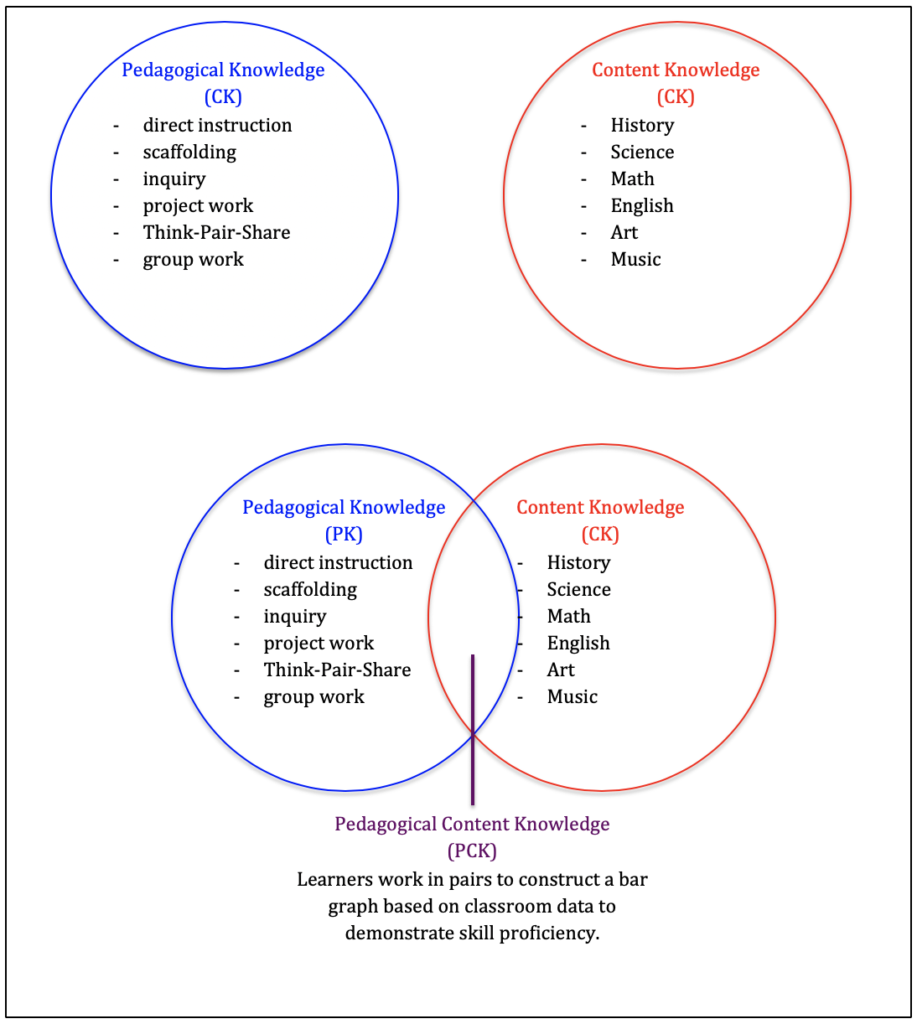
With growth in educational technologies, Mishra and Koehler (2006) have argued technology influences both content and pedagogy, thus highlighting a need for technological knowledge (TK) in good teaching. This third dimension, represented in Figure 2, interconnects forming Technology Pedagogical and Content Knowledge (TPACK). TK includes the knowledge and associated skills of educational technologies (Koh et al., 2013; Mishra & Koehler, 2006). Technological content knowledge (TCK) is knowledge about how technology can be used to teach content (Koh et al., 2013; Mishra & Koehler, 2006). For example, multiplication can be taught using physical manipulatives or a slide ruler. Alternatively, computer software can teach multiplication using digital manipulatives being re-grouped by use a mouse. Technological pedagogical knowledge (TPK) is knowing how technologies are used in teaching and learning settings, and how teaching might change as the result of using particular technologies (Mishra & Koehler, 2006). Technological pedagogical content knowledge (TPACK) requires an understanding of how technology can be used to represent content, pedagogical techniques to effectively use technology, and how technology can improve learning. (Mishra & Koehler, 2006).
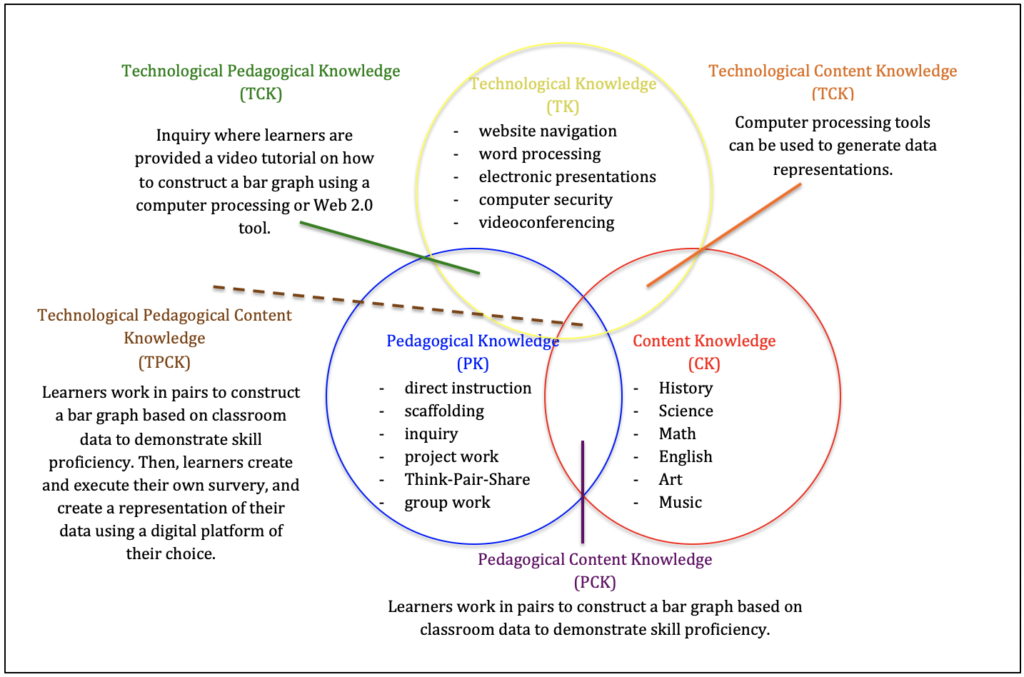
TPACK as a Framework for Engaging in Collaboration
Finding an entry point for a TL to engage in professional collaboration that cultivates effective instructional design to co-plan, teach and assess learning can be difficult. However, TPACK can be used to identify an area of needed expertise to advance student learning through a collaborative approach. Much like Leading Learning: Standards of Practice for School Library Learning Commons in Canada (Canadian School Libraries, 2020), an educator’s practice can be seen as being on a continuum of growth, never attaining mastery. Embracing a growth mindset (Dweck, 2006), the TL can use TPACK to identify the co-teacher’s strengths and ideas while also identifying areas where support will compliment the desired outcome. For example, if the classroom teacher is confident in direct instruction (PK) in a particular content area, such as physical geography (CK), the TL can use TPACK to identify these components for the task (see Figure 3). From here, the TL can use his/her expertise with information literacy to provide content-specific resources to enrich learning or suggest TK elements, such as a digital slide presentation or an online researching task, to build the technological competencies of learners. This approach also helps distinguish roles and responsibilities for each collaborator. As illustrated in Figure 3, teaching roles can be divided with the classroom teacher leading the direct instruction on various physical geography features, such as mountains, valleys, and hills. The TL can lead learning on finding information using indexes in school texts and using keyword searches online. The classroom teacher can provide the activity outlining required learning outcomes and the TL can create a visual slide presentation providing visuals for each of the physical features being investigated.
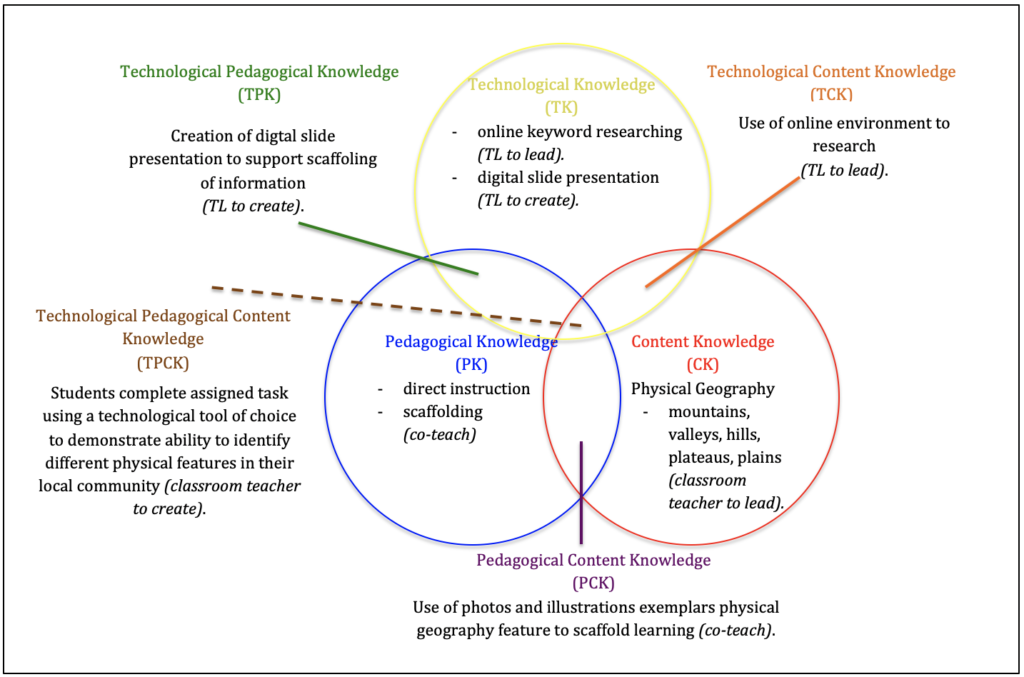
An Exemplar in Humanities
A grade 3/4 teacher in British Columbia, Canada approached the TL, and author, to co-plan an activity on the Canadian fur trade in Social Studies (CK). Through initial collaboration, the classroom teacher identified her preference for instruction, a structured inquiry resulting in an individual journal writing assignment (PK). Through knowledge building, students were to practice online researching previously scaffolded in a prior collaboration (TK). However, while the classroom teacher chose the CK for the collaboration, she also identified a need for support. The TL agreed to take responsibility in this area, and set aside text-based resources within the school while also utilizing the virtual learning commons to upload grade-appropriate research links, videos, and interactive role-play games (TK). A performance task was created where students chose the role of a voyageur, trading post employee, explorer, or woman in the fur trade (PCK). The task was to curate a journal highlighting their chosen role, responsibilities and accompanying challenges. The TL created a template for learners to collect information (CK), and the classroom teacher created a criteria sheet. The TL also suggested including two feedback loops prior to final assessment (PK).
Lessons on the fur trade and how to structure a journal entry were co-taught by the classroom teacher and TL (CK). As teams began to finish rough copies, a rubric was provided for students to self-assess progress, identify areas of improvement, and make revisions (PK/CK). Next, a peer feedback loop was implemented, providing further feedback. Then, students completed final revisions and created their final copy. These were handed in for final summative assessment, co-assessed by the TL and classroom teacher. Please see Figure 4 for a visual representation.
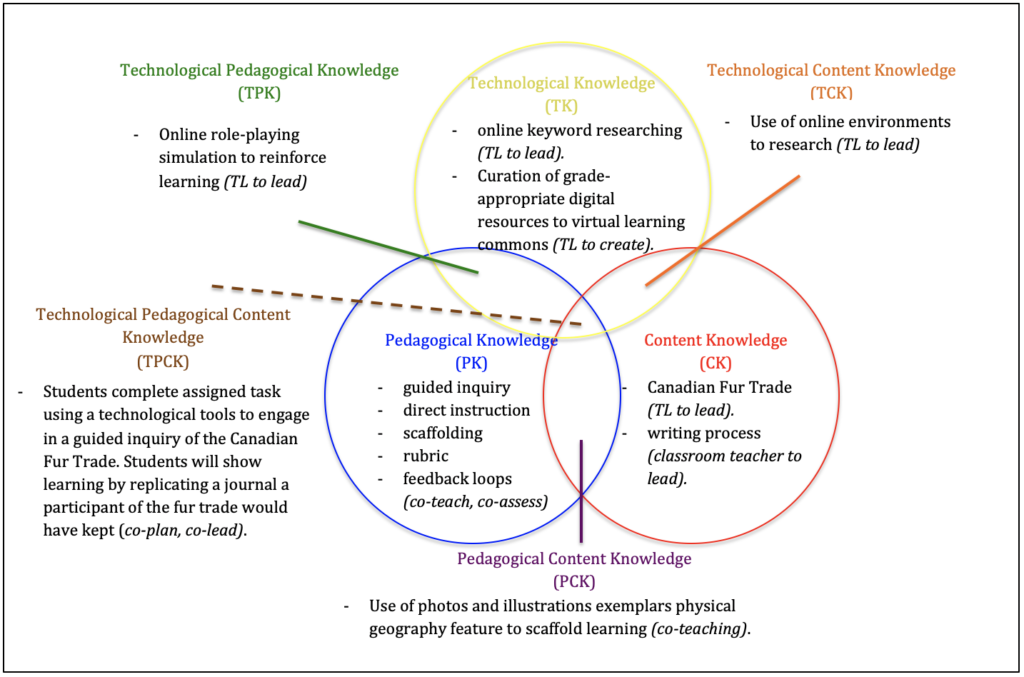
An exemplar in interdisciplinary task design
Inspired by a pre-service teacher, the novel Life as We Knew It (Pfeffer, 2006) was used to guide an interdisciplinary unit in grade 8 English (CK). Both the classroom teacher and pre-service teacher met with the TL with the following inquiry question: How might we survive in a world where the moon is closer to Earth? A guided inquiry (PK) was designed to present students with the role of being recruited by their community to devise a plan for how to survive in a world where the moon is closer to Earth. They were tasked with designing a strategy around one particular area that will help humans survive and thrive in their new reality. Areas included natural resources, technology, business, communication and human service. The goal was to convince their community to choose their strategy for how society should proceed. As this inquiry developed, the TL recognized a cross-curricular connection to Science, linking to mechanical systems (CK).
Using TPACK, the TL used the mechanical systems curricular connection (CK) as an entry point with the science department, and the design approach of an interdisciplinary performance task (TPCK) to gain support of the humanities department. The TL requested a meeting all humanities and science teachers, including 11 teachers, to discuss the interdisciplinary inquiry. Integrating collaborative input from all teachers, students were tasked with devising a plan of how to survive in a world where the moon is closer to Earth.
While reading through the novel, students were provided direct instruction and research tasks on magnetism, astronomy and simple machines in science class (TCK). Students were then asked to choose a sector of altered society to investigate and explore as a focus area, answering two questions: (1) How did people do this before the moon disaster?; and, (2) How are people able to accomplish this after the moon disaster? Next, each student developed a sixty-second pitch to briefly explain the potential solution for their chosen area, and design teams were formed (PK). Students then created a prototype, or rough exemplar, of their solution. With support from the TL, time was provided in both humanities and science classes, with students being allowed to access multiple teachers during instructional time, allowing students to receive feedback from all disciplines (PCK) as well as support in designing authentic prototypes. Prototypes included the use of technological tools (TK) such as 3D printers and Google Apps for Education. Exhibits were created and a mock town hall meeting was conducted where each group gave a persuasive speech (PCK) with their prototype and answered questions raised by the community (PCK). Both the humanities and science teachers were present and used this time to collaboratively each project according to criteria complimenting their subject area. Please see Figure 5 for a visual representation.
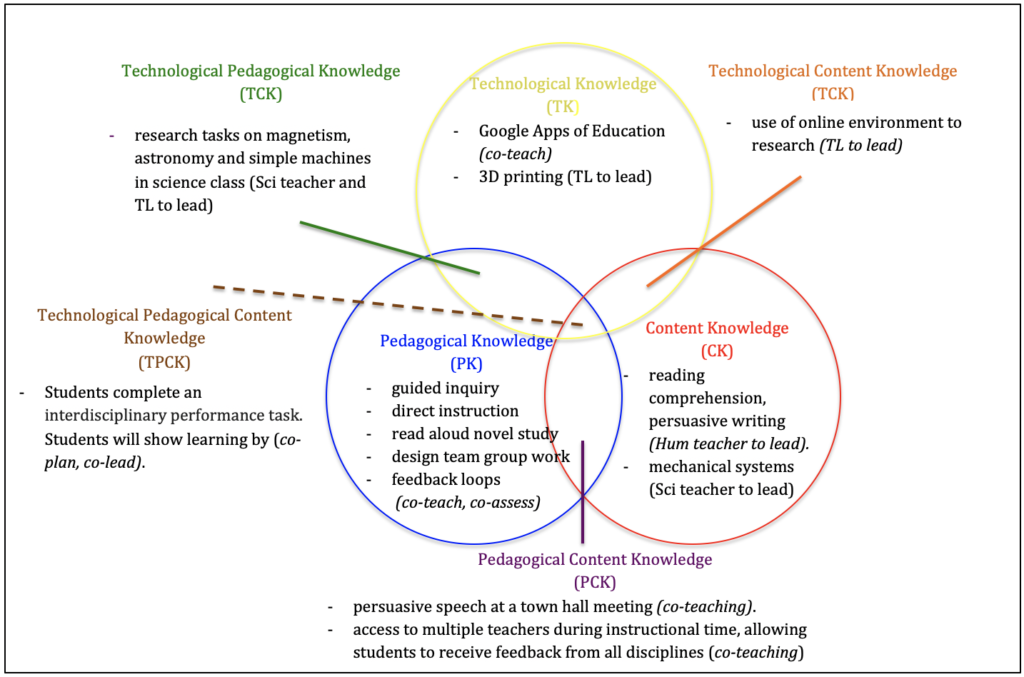
Strengths of TPACK as a Framework for TL Co-Planning, Teaching and Assessing
TPACK as a framework for TL co-planning, teaching and assessing has strengths. TPACK assists in identifying and proposing potential entry points and sources of support to compliment the strengths of the classroom teacher. For example, the TL can provide CK expertise to help in areas where a teacher self-identifies support is needed. This can be particularly beneficial in elementary contexts where the classroom teacher is responsible for delivering instruction in all core subject areas. TPACK can also be used to assist the TL in identifying CK and PK connections between disciplinary areas to support interdisciplinary task design. With a broader perspective encompassing multiple curricular areas, identifying overlapping curricular connections becomes easier for the TL. Further, entry points in assessment practices, such as formative feedback loops, and technological knowledge, such as research and ICT skills, can be used.
TPACK can act as a tool to build relationships with colleagues. If used as a framework to identify areas of strengths, teaching preferences and areas of support, the TL can better understand the teaching approaches, such as inquiry or project-based learning, and possible learning technologies to be integrated. TPACK also lends itself to promoting collaborative conversations where all participants can have their voices heard. Because there are multiple components to be considered, this invites multiple perspectives and ideas. This can help build strength-based, positive relationships in an environment where ideas can be heard. It also helps foster a culture of growth mindset (Dweck, 2006), as when multiple ideas and perspectives are considered, new learning can occur.
Challenges of TPACK as a Framework for TL Co-Planning, Teaching and Assessing
While TPACK as a framework for TL collaboration has strengths, it also poses significant challenges. First TPACK requires a TL to be an expert in varying curricular, pedagogical and technology knowledge areas. This requires the TL to not only be a lifelong learner, but also a professional who stays current in research and pedagogy. As new forms of teaching and learning emerge, the TL must be willing to take risks and encourage peers to do so as well. In order for this to occur, the TL must also have strong, positive relationships with colleagues, which can also be a significant barrier. Not all teachers share similar philosophies on teaching and learning, nor agree on what approaches work best for student learning in a given context. Last, TPACK also requires a large degree of flexibility from the TL. The TL must be willing to put his or her philosophies and pedagogical preferences behind in order to engage in collaboration and move student learning forward.
Conclusion
The transition towards LLC as a school hub transforming school culture is exciting. Still integral to fostering the love of literacy, the LLC thrives on collaboration, which has resulted in a shift in the traditional role of the TL. Now, a larger emphasis on cultivating effective instructional design to co-plan, teach and assess learning requires the TL to break classroom isolation barriers and build participatory learning opportunities for students. Amplifying this is the proliferation of technology in education, requiring a new and complex skillset for educators. TPACK is a model that can be employed to support TLs in this role through a positive, strength-based approach. TPACK provided multiple entry points for collaborative conversations, embraces all pedagogical approaches and supports a culture of continual growth.
References
Ball, D. L., & McDiarmid, G. W. (1990). The subject matter preparation of teachers. In W. R. Houston (Ed.), Handbook of research on teacher education, 437–449. New York: Macmillan.
Canadian School Libraries (CSL). 2020. Leading Learning: Standards of Practice for School Library Learning Commons in Canada. Accessed at: http://llsop.canadianschoollibraries.ca. (Original version published by the Canadian Library Association, 2014.)
Dweck, C. S. (2006). Mindset: The new psychology of success. New York: Random House.
Eckdahl, M. & Zubke, S. (2017). From school library to library learning commons: A pro-active model for educational change. British Columbia: British Columbia Teacher-Librarians Association.
Koh, J., Chai, H., & Tsai, L. (2013). Examining practicing teachers’ perceptions of technological pedagogical content knowledge (TPACK) pathways: A structural equation modeling approach. Instructional Science, 41(4), 793-809.
Loertscher, D., and Koechlin, C. (2014). Climbing to excellence: Defining characteristics of successful learning commons. Knowledge Quest, 42(4), 1-10.
Loertscher, D., Koechlin, C., and Rosenfeld, E. (2012). The virtual learning commons: Building a participatory school learning community. Salt Lake City, UT: Learning Commons.
Loertscher, D., Koechlin, C., and Zwaan, S. (2008). The new school learning commons: Where learners win. Spring, TX: Hi Willow.
McMullen, S. (2008). US Academic Libraries: Today’s Learning Commons Model. PEB Exchange, OECD.
Mishra, P. & Koehler, M.J. (2006). Technological Pedagogical Content Knowledge: A Framework for Teacher Knowledge. Teachers College Record, 108(6), 1017-1054.
Ontario School Library Association. (2010). Together for Learning: School Libraries and the Emergence of the Learning Commons.
Pfeffer, S. (2006). Life as we knew it. San Diego, CA: Hardcourt Children’s Books
Shulman, L. S. (1986). Those who understand: Knowledge growth in teaching. Educational Researcher, 15(2), 4–14.
Veal, W. R., & MaKinster, J. G. (1999). Pedagogical content knowledge taxonomies [Electronic version]. Electronic Journal of Science Education, 3(4).

Amber Hartwell (@amber_hartwell) works for Central Okanagan Public Schools as a teacher-librarian and the University of Calgary as both a sessional instructor and research assistant. She co-chairs her district’s Library Learning Commons Committee, providing professional learning for over 50 teacher-librarians, and consults for school boards in the Central Okanagan on transitioning libraries to library learning commons. Amber completed her BA in History at Okanagan University College, teaching certification through the University of Victoria, and Master of Education in Learning Sciences with the University of Calgary. Her research on flipped classroom pedagogy received a national award in 2016 from both the Canadian Journal of Learning & Technology and the Canadian Network for Innovation in Education. With a passion for meaningful integration of technology in education, Amber is currently working towards her EdD in Learning Sciences through the University of Calgary. You can follow her journey on her professional blog: amberhartwell.wordpress.com.